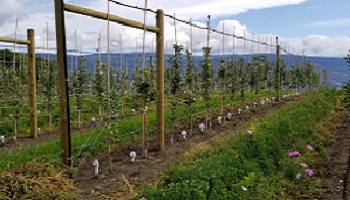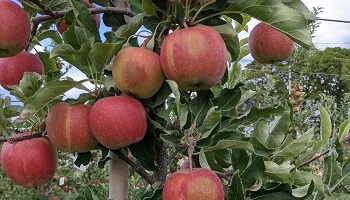For more information
Media Relations
Agriculture and Agri-Food Canada
1-866-345-7972
aafc.mediarelations-relationsmedias.aac@agr.gc.ca
A summer of extreme heat devastated tree fruits across British Columbia in 2021, with the apple sector being just one of many that saw considerably lower yields and deteriorated quality at harvest. Increasing the resiliency of our crops will be vital in sustaining the apple sector going forward, and one way to do this is by selecting the right rootstock. Dr. Hao Xu, a research scientist at Agriculture and Agri-Food Canada, has discovered that larger and more vigorous rootstocks can play a key role in alleviating heat stress in apples.
To put this to the test, Dr. Xu’s team at the Summerland Research and Development Centre conducted field trials with ‘Ambrosia’ apples produced from 5 rootstocks of differing size – the large-dwarfing Geneva 935 and Geneva 202; the moderate-dwarfing Malling 26 and Malling 9NIC29; and the small-dwarfing Budagovsky 9. By the end of the third growing season, trunk cross section diameter at 30 cm above graft union was 25.9 mm on Malling 9NIC29, which was similar to the other moderate-dwarfing Malling 26, 13% larger than small-dwarfing Budagovsky 9, and 14% smaller than the 2 large-dwarfing Geneva rootstocks.
The team used an apple delta absorbance (DA) meter, a rapid and non-destructive handheld tool, to help in detecting and evaluating symptoms of sunburn browning at the preharvest stage. “We found that this tool was reliable and efficient in giving us a better understanding of heat stress related changes in the apple skin on a cellular level,” says Dr. Xu. “We’re now working on refining the protocol of using the DA meter to assist in early detection and evaluation of sunburn browning severities on affected fruits.”
After comparing and evaluating the yields of each rootstock, the team found that the large-dwarfing Geneva 935 was the most successful in mitigating sunburn damage. The study revealed that when soil moisture was adequate, the larger rootstocks had a better capacity to transport water, which allowed for a higher stem water potential and a more transpirational cooling effect. Additionally, this rootstock was shown to produce a larger canopy volume, which helped in shading the crops against sun exposure. All of these characteristics effectively contributed to alleviating heat stress in the crops and reducing sunburn damage. Dr. Xu’s team has also found similar outcomes from trials with the ‘Buckeye Gala’ variety, suggesting large-dwarfing rootstocks can benefit more than just ‘Ambrosia’ apples.
“Our research will be vital in providing key information to facilitate decision making on the use of innovative large-dwarfing rootstocks in order to enhance production resilience in a warmer climate.”
- Dr. Hao Xu, Research Scientist, Agriculture and Agri-Food Canada
As the climate becomes more and more unpredictable for growers, rootstock selection may prove to be a viable long-term measure towards building resilience in apple orchards. While small-dwarfing rootstocks are the industry standard as of now, Dr. Hao Xu is hoping her research can demonstrate the importance of incorporating larger rootstocks. “When managed appropriately, large-dwarfing rootstocks can not only increase yield efficiency per acre, but they can also enhance crop resilience to extreme temperatures,” explains Dr. Xu.
The apple sunburn research was conducted in collaboration with Dr. Suzanne Blatt from Kentville Research and Development Centre, and Dr. Yoichiro Watanabe, Dr. Kelly Ross and Dr. Xiaotang Yang from Summerland Research and Development Centre. Danielle Ediger, Davis Iritani, Lana Fukumoto and Kandace Zurowski-Tiffin provided technical support.
Key discoveries and benefits
- Dr. Hao Xu’s team conducted field trials with ‘Ambrosia’ apples produced from 5 rootstocks of differing size, and found that the large-dwarfing Geneva 935 rootstock was the most successful in reducing sunburn damage.
- The study revealed that the larger rootstocks had a better capacity to transport water, which allowed for a higher stem water potential and a more transpirational cooling effect, and produced a larger canopy volume that helped in shading the crops against sun exposure.
- The study also found that the DA meter, a rapid and non-destructive handheld tool, is reliable and efficient in detecting sunburn browning in apples at the preharvest stage, and can assist in early detection and evaluation of heat-related damages to the fruit skin.
Photo gallery


